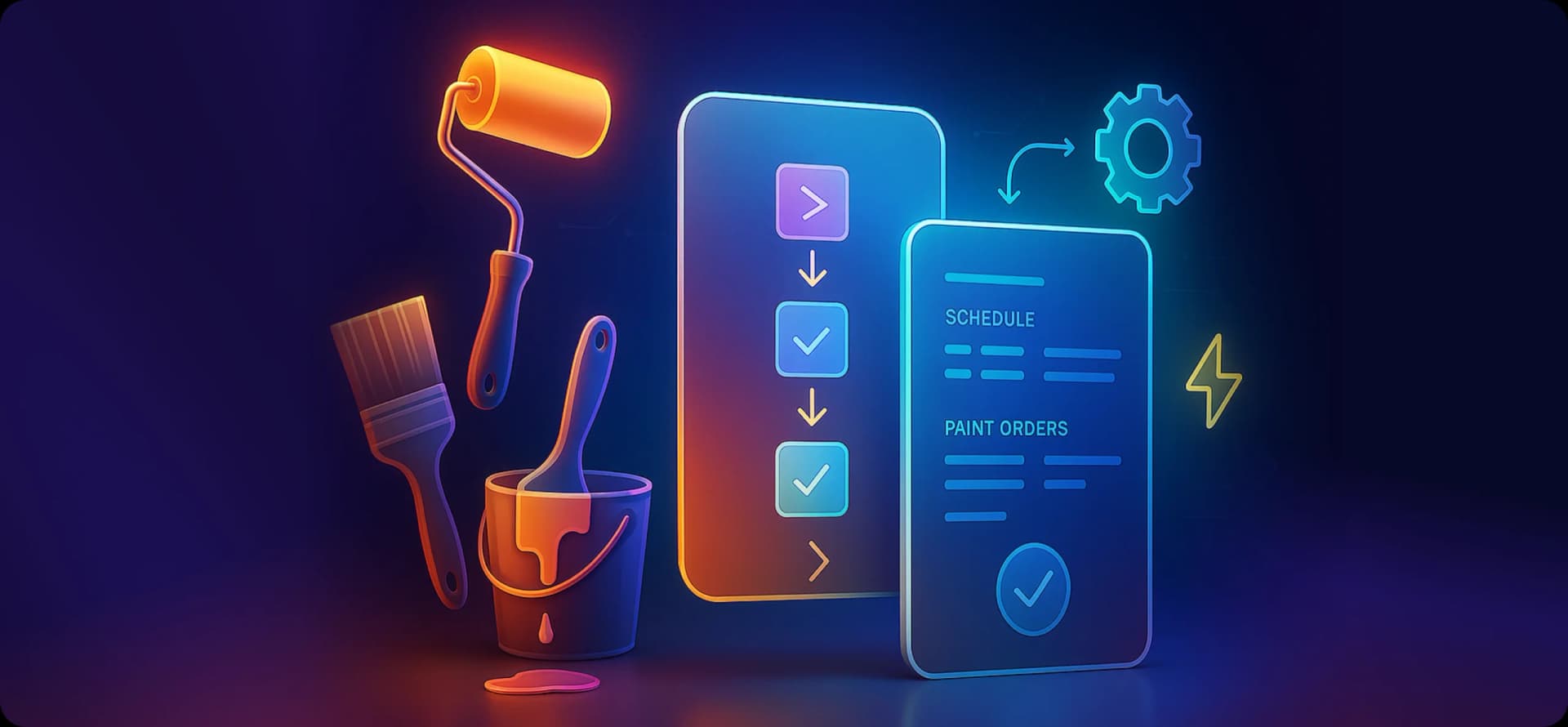Last Tuesday morning started like a house of cards collapsing. A painting contractor’s phone rang three times before 8 AM: team stuck in traffic, angry customer asking about project updates, and materials delivered to the wrong job site.
The next four hours disappeared into phone calls, apologetic texts, and frantically updating schedules on paper and spreadsheets. Real painting work? That didn’t start until the afternoon. The day’s profits? Gone.
This happens every day in painting businesses everywhere. “Managing projects” means chasing crews, hunting for updates, and keeping everything organized in your head. Missed appointments pile up. Customers get frustrated. Growth stops because there’s no time left for actual business building.
But some painting contractors escape this daily chaos. They use workflow automation—smart systems that handle the repetitive stuff automatically. No more phone tag. No more forgotten follow-ups. No more scrambling to find information.
Here’s exactly how these automated workflows transform scattered, stressful painting businesses into smooth, profitable operations that scale.
Are you a visual learner? Check out our video below 👇
What is Workflow Automation for Painting Contractors?
Workflow automation for painting contractors means using technology to automatically handle repetitive business tasks without manual intervention. Instead of manually assigning teams to jobs, sending reminder texts, or tracking project hours on paper, automated systems handle these processes based on predefined rules and triggers.
Think of workflow automation as your digital assistant that never sleeps. When a new estimate request comes in, the system automatically creates a task, assigns it to the right estimator, sets follow-up reminders, and tracks the entire process from initial contact to project completion.
Common painting business workflows that benefit from automation include:
- Lead capture and immediate task assignment to the sales team
- Team scheduling based on availability, skills, and job location
- Material ordering when the inventory system hits reorder points
- Customer notifications for project milestones and delays
- Invoice generation upon project completion
- Payment reminder sequences for overdue accounts
Manual vs. Automated processes: The time-saving reality
The difference between manual and automated processes is dramatic when you calculate the actual hours involved:
| Category | Manual process | Automated process |
| Step 1 | Review new jobs and crew availability (15 min) | System reviews job requirements and crew availability automatically |
| Step 2 | Call or text each crew member individually (30 min) | Sends notifications to assigned crew members instantly |
| Step 3 | Update schedules and notify customers (15 min) | Updates the customer portal with crew assignment details |
| Total Time | ≈ 60 minutes daily | ≈ 2 minutes (review & approve) |
Manual processes also introduce costly errors:
- Double-booked crews are leading to project delays
- Forgotten follow-ups resulting in lost leads
- Inaccurate time tracking is affecting profitability
- Missed payment reminders are impacting cash flow
Automated workflows eliminate these human errors while freeing up 6-10 hours weekly that you can reinvest in growing your business or improving service quality.
How does automation solve these core problems?
The errors listed above aren’t just inconveniences; they’re profit killers that compound over time. Here’s how modern workflow automation platforms address each challenge with specific solutions:
Problem 1: Double-Booked Crews and Project Delays
Solution: Intelligent Crew Assignment Systems
Modern field service platforms prevent double-booking through real-time crew availability tracking. When a new project gets scheduled, the system automatically checks current assignments, travel times, and project durations before suggesting available crews.
This eliminates the guesswork that leads to scheduling conflicts.
Problem 2: Forgotten Follow-ups and Lost Leads
Solution: Automated Lead Response & Follow-up Systems
Instead of relying on memory or manual reminders, automated systems ensure every lead gets consistent follow-up. From the moment a potential customer expresses interest, predetermined sequences activate automatically, maintaining engagement until conversion or definitive closure.
Problem 3: Inaccurate Time Tracking Affecting Profitability
Solution: GPS-Verified Time Tracking and Progress Monitoring
Automated time tracking eliminates guesswork and provides accurate labor cost data for future estimates. GPS verification ensures crews are on-site during claimed work hours, while photo-based progress updates create accountability without micromanagement.
Need precise labor costing? FieldCamp’s labor cost calculator delivers accurate results every time.
Problem 4: Missed Payment Reminders and Cash Flow Impact
Solution: Automated Invoice Generation and Payment Collection
Financial automation ensures invoices get created immediately upon project completion, and payment reminders follow systematic schedules. This reduces average collection times from 45-60 days to 15-25 days, dramatically improving cash flow.
These automation solutions work together to create a comprehensive system that eliminates the daily chaos described in our opening scenario.
Let’s examine each area in detail with real-world examples of how leading painting contractors implement these solutions.
Meanwhile, you’re at it, we recommend that you check out how easy it is to implement painting contractor software in your workflow.
Best Lead Management Automation Tools for Painting Businesses
1. Automatic Lead Capture and Assignment
Modern lead management automation begins the moment a potential customer expresses interest in your services. Instead of leads sitting in an inbox or voicemail system for hours, automated systems capture and route them instantly.
Example: Lead Response & Follow-Up Automation
Modern field service platforms like FieldCamp demonstrate how lead automation works in practice.
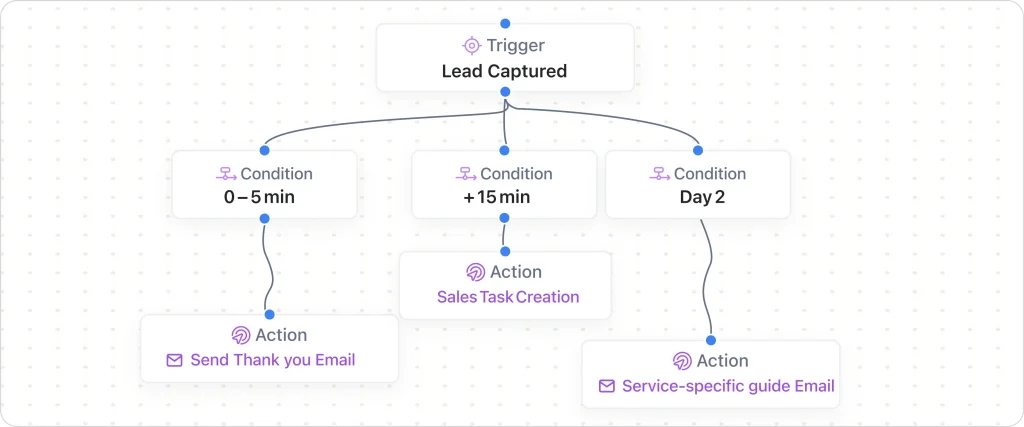
When a potential customer submits an estimate request through your website, here’s the automated sequence:
Automated lead capture workflow:
Website Form Submission → Instant Lead Creation → Geographic Assignment → 2-Hour Response Guarantee → Follow-up Sequence Activation
Process breakdown:
- Lead intake: System captures project details (interior/exterior, square footage, timeline, address)
- Smart assignment: Automatically routes to the closest available estimator with relevant experience
- Instant response: Customer receives immediate confirmation with the estimator’s details
- Internal notification: Estimator gets text with customer info and optimal driving route
- Follow-up schedule: Automated sequence begins (estimate, proposal, follow-ups)
Smart assignment criteria:
- Project size and complexity (cabinet work vs. full exterior)
- Geographic location and travel time optimization
- Estimator availability and current workload
- Historical performance with similar project types
This ensures every lead receives appropriate attention within your target response time, typically 30 minutes to 2 hours, depending on your market positioning.
2. Follow-up sequence automation
Following up consistently separates successful painting contractors from those who struggle with lead conversion. Automated follow-up sequences ensure no potential customer falls through the cracks.
Automated follow-up timeline:
- Day 1: Immediate acknowledgment and appointment scheduling
- Day 3: Estimate delivery with project timeline
- Day 7: Follow-up call or email, checking for questions
- Day 14: Final follow-up with a limited-time incentive
- Day 30: Quarterly newsletter addition for future projects
Advanced follow-up features:
- Seasonal triggers: Interior painting offers during the winter months
- Behavior-based: Different sequences for website visitors vs. phone inquiries
- Geographic targeting: Weather-based messaging for exterior projects
- Project-specific: Custom sequences for commercial vs. residential leads
The system tracks open rates, response rates, and conversion metrics, allowing you to refine messaging and timing for optimal results.
3. Lead nurturing and qualification workflows
Not every lead is ready to buy immediately. Automated nurturing workflows keep your business top-of-mind while qualifying prospects for future projects.
Nurturing workflow components:
- Educational content: Tips for paint selection, seasonal painting advice
- Social proof: Customer testimonials and project showcases
- Seasonal reminders: Optimal timing for interior vs. exterior projects
- Maintenance alerts: Follow-up for touch-ups or new projects
Qualification scoring:
- Website behavior tracking (pages visited, time spent)
- Email engagement rates (opens, clicks, responses)
- Phone call responses and appointment scheduling
- Social media interaction levels
The system automatically moves highly qualified leads into active sales sequences while continuing to nurture others until they’re ready to move forward.
Project Management Automation: Task Assignment and Time Tracking Solutions
1. Job scheduling and crew assignment automation
Efficient crew management is the backbone of successful painting operations. Automated task assignment eliminates the daily scramble of figuring out who goes where, replacing it with intelligent scheduling that considers multiple factors simultaneously.
Example: Intelligent Crew Assignment
Consider how platforms handle the complex logistics of crew scheduling. When a new project gets confirmed, the system analyzes:
Smart assignment factors:
- Skill matching: Interior specialists for detailed trim work, exterior experts for siding projects
- Geographic optimization: Minimize travel time between jobs
- Workload balancing: Prevent team burnout while maximizing productivity
- Equipment requirements: Match crews with the necessary tools and vehicles
Real-time assignment process:
- New project confirmed → System analyzes requirements
- Available crews identified based on skills and schedule
- Travel time calculated from the current or home location
- Automatic notifications are sent to assigned crew members
- Customer receives crew assignment and arrival time
- Calendar updates reflect new assignments across all platforms
Modern systems also handle last-minute changes seamlessly. When weather delays outdoor work, the system can automatically reassign the team to interior projects or reschedule based on forecast improvements.
2. Material ordering and inventory triggers
Running out of materials mid-project costs time, money, and customer satisfaction. Automated inventory management ensures supplies stay stocked without over-ordering.
Example: Inventory & Parts Management Automation
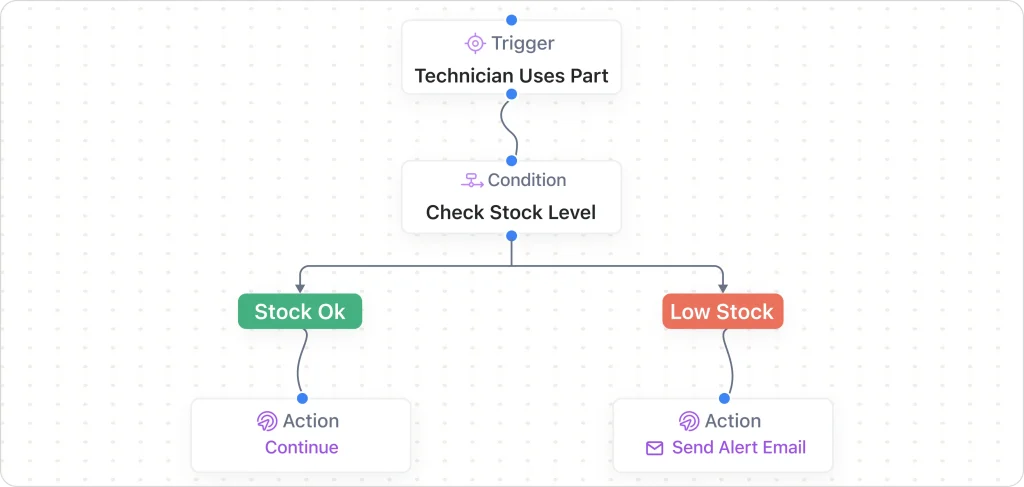
Leading field service platforms demonstrate how smart inventory management prevents material shortages:
Smart inventory workflow:
Project Scheduled → Material Calculation → Inventory Check → Auto-Reorder → Delivery Coordination → Job Site Verification
Automated reorder features:
- Project-based calculations: System estimates paint needs based on square footage and surface type
- Real-time inventory tracking: Minimum stock levels trigger automatic purchase orders
- Supplier integration: Direct ordering from preferred vendors with negotiated pricing
- Delivery scheduling: Coordinates material arrival with project start dates
Smart ordering intelligence:
- Historical usage patterns for accurate forecasting
- Seasonal adjustments for interior vs. exterior work demands
- Bulk pricing optimization for cost savings
- Alternative supplier activation for emergency orders
This eliminates emergency supply runs during projects while reducing material waste through accurate ordering.
3. Progress tracking and status updates
Keeping projects on schedule requires constant monitoring and proactive communication. Automated progress tracking provides real-time visibility without consuming crew time.
Example: Real-Time Customer Job Status Updates
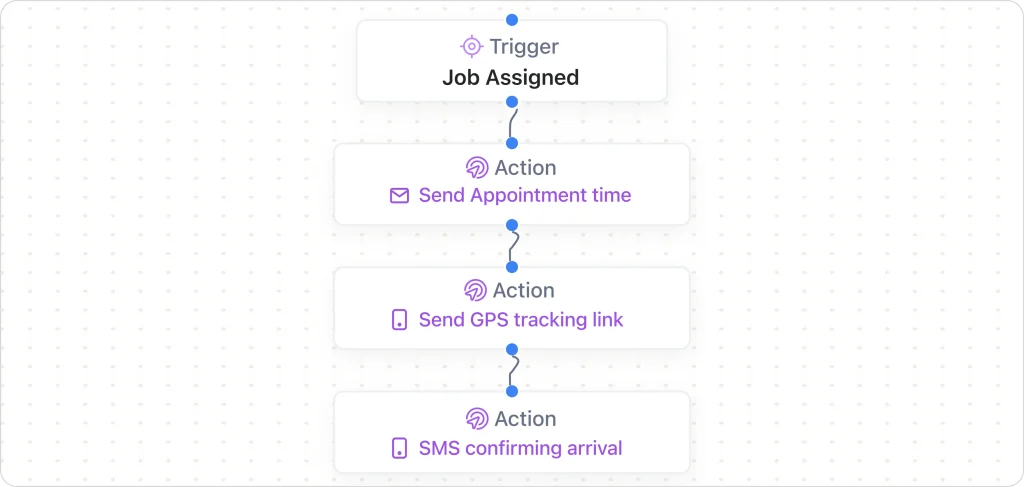
Modern platforms show how automated progress updates work in practice:
Photo-based progress workflow:
Daily Check-in → Photo Upload → Progress Validation → Customer Notification → Quality Review → Next Day Planning
Automated progress features:
- Mobile integration: Crews upload photos with simple project stage selection
- Customer portal: Real-time project gallery with completion percentages
- Automatic notifications: Progress descriptions that match photo categories
- Quality control: System flags delayed milestones or coverage issues
- Manager dashboard: Multi-project oversight with status indicators
Stakeholder communication:
- Customer portal access for real-time project viewing
- Automatic email updates at major milestones
- Text notifications for schedule changes or delays
- Manager dashboard for multi-project oversight
This transparency builds customer confidence while providing managers with information needed to keep projects on track and profitable.
4. Quality control checkpoint automation
Consistent quality separates professional painting contractors from competitors. Automated quality control ensures standards are maintained across all projects and crews.
Quality checkpoint system:
- Pre-work inspections: Surface preparation verification with photo documentation
- Material quality checks: Paint mixing and application standards monitoring
- Progress inspections: Coverage and technique verification at key milestones
- Final quality review: Complete project assessment before customer walkthrough
Automated quality features:
- Checklist reminders sent to crew leaders at appropriate stages
- Photo requirements for quality documentation
- Customer feedback integration for continuous improvement
- Performance tracking by the crew and individual painters
This ensures every project meets your standards while building a reputation for excellence that drives referrals and repeat business.
Get Workflow Simplicity in Minutes
Let FieldCamp’s workflow builder automate the details so you can focus on delivering quality, simplicity, and control in one place.
Automated Customer Communication Systems for Painting Contractors
1. Appointment confirmation and reminder systems
Missed appointments cost painting contractors thousands in lost revenue and rescheduling expenses. Automated reminder systems virtually eliminate no-shows while improving customer satisfaction through proactive communication.
Example: No-Show Prevention System
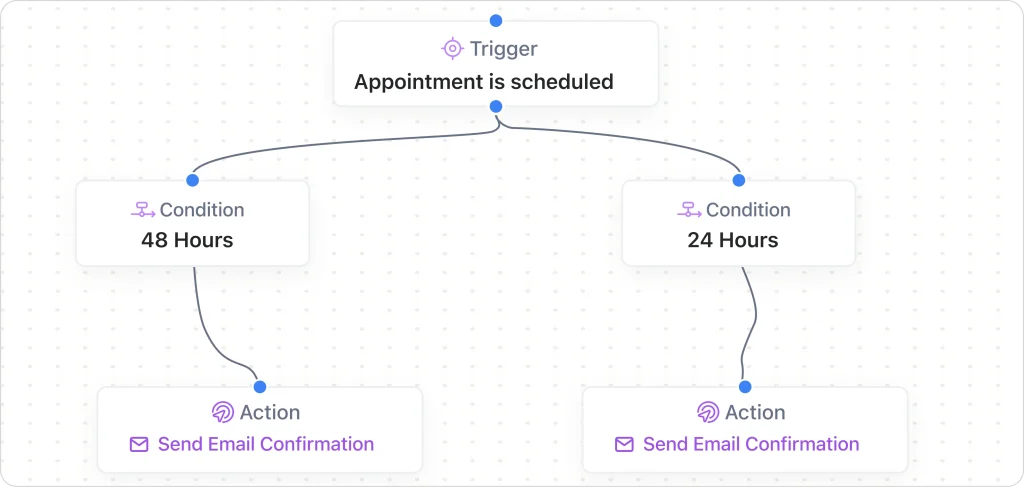
Modern field service platforms demonstrate how automated reminders prevent missed appointments:
Multi-touch reminder workflow:
Appointment Scheduled → 48-Hour Email → 24-Hour SMS → Morning-Of Call → Weather Contingency Check
Smart reminder features:
- Weather integration: Automatic rescheduling suggestions for exterior work
- Customer preferences: Email vs. text based on individual preferences
- Crew information: Names and photos of arriving team members
- Preparation instructions: Specific guidance for different project types
Painting-specific reminder content:
- “Tomorrow’s forecast looks perfect for your exterior painting!”
- “Please move patio furniture 3 feet from the house walls.”
- “Your painters, Mike and Tom, will arrive in a white van at 8 AM.”
- “Weather delays? Text this number for immediate update.”
The system tracks reminder effectiveness and adjusts timing based on customer response patterns.
2. Project update notifications
Keeping customers informed throughout the project builds trust and reduces anxiety. Automated update systems provide regular communication without consuming crew time.
Progress update automation:
- Daily Photos: Automatically sent with progress descriptions
- Milestone Notifications: Key project stages completed
- Schedule Updates: Real-time adjustments for weather or delays
- Quality Checkpoints: Completed inspections and approvals
Customer Portal Integration:
- Real-time project dashboard access
- Photo galleries with completion timestamps
- Direct messaging with project managers
- Invoice and payment status tracking
This transparency often leads to positive reviews and referrals, as customers appreciate being kept informed throughout the process.
| Do You Know Contractors Save Hours with FieldCamp? See how FieldCamp automates task assignment, customer reminders, and time tracking that transforms painting operations. Watch Now |
3. Payment reminder automation
Consistent payment collection is crucial for cash flow management. Automated reminder sequences ensure invoices get paid promptly while maintaining positive customer relationships.
Payment reminder sequence:
- Day 0: Invoice delivery with payment options
- Day 10: Friendly reminder with payment link
- Day 20: Formal notice with late fee warning
- Day 30: Final notice before collections
Personalized messaging:
- Different tone for first-time vs. repeat customers
- Project-specific references for context
- Multiple payment option highlights
- Customer service contact information
The system automatically stops reminder sequences when payments are received and can integrate with accounting software to sync payment status across all platforms.
Do you know how to save time and boost profits? Explore how to integrate tools in your painting contractor software that will save effort.
4. Review and feedback request workflows
Positive reviews drive new business, while feedback helps improve service quality. Automated review requests ensure consistent reputation management.
Review request timeline:
- Project completion: Immediate satisfaction survey
- 48 hours later: Google and Yelp review requests
- 1 week later: Follow-up for outstanding reviews
- 1 month later: Referral request and testimonial gathering
Feedback collection automation:
- Short satisfaction surveys via text or email
- Photo sharing requests for portfolio building
- Testimonial collection with usage permissions
- Problem identification and resolution tracking
This systematic approach to reputation management builds a strong online presence that attracts new customers and supports premium pricing.
Financial Process Automation
1. Invoice generation and sending automation
Manual invoice creation consumes valuable time and introduces errors that can delay payment. Automated invoice generation ensures accurate, timely billing that accelerates cash flow.
Example: Estimate-to-Cash Automation
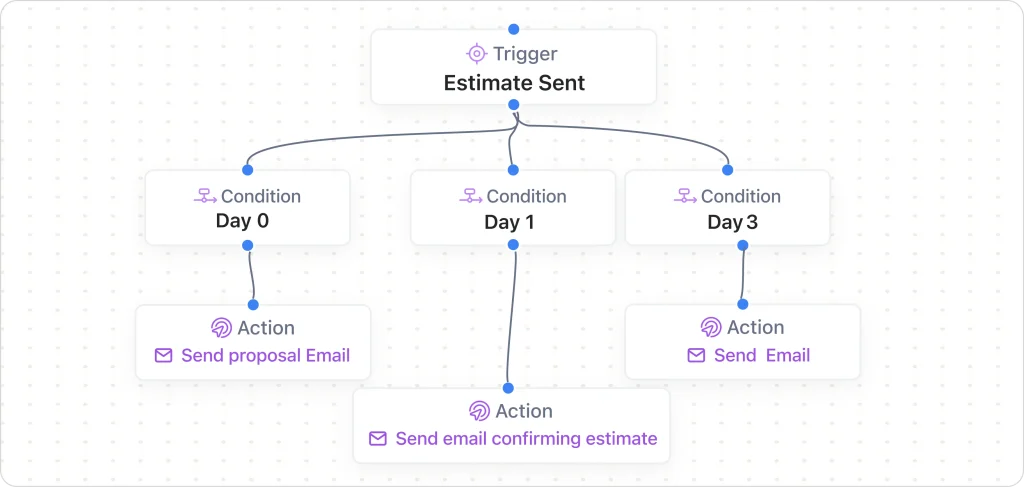
Leading platforms demonstrate how complete sales-to-payment automation works:
Complete sales cycle workflow:
Estimate Approved → Contract Generation → Deposit Collection → Work Scheduling → Progress Billing → Final Invoice → Payment Follow-up
Automated invoice features:
- Template customization: Branded invoices with detailed line items
- Tax calculation: Automatic tax application by location
- Payment options: Multiple payment methods with processing links
- Document attachment: Photos, contracts, and change orders included
Painting industry customizations:
- Color approval integration with digital color selection
- Material cost tracking with real-time supplier pricing
- Weather delay adjustments for schedule modifications
- Warranty documentation with service guarantees
Looking for a quick and reliable solution? Try our free painting invoice template to get your work done faster.
2. Payment processing and recording
Connecting payment processing to your project management system provides complete financial visibility and eliminates manual data entry.
Example: QuickBooks Sync & Invoice Automation
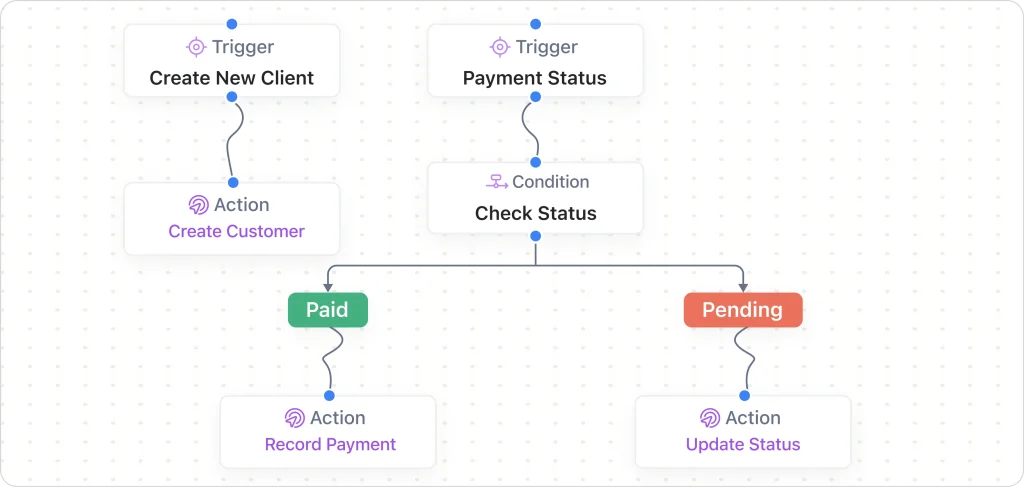
Modern field service platforms show how financial integration eliminates manual bookkeeping:
Complete financial workflow:
Project Completion → Invoice Generation → QuickBooks Sync → Payment Processing → Expense Categorization → Financial Reporting
Financial integration features:
- Automatic invoice creation: Project data flows directly into branded invoices
- QuickBooks sync: Real-time financial data synchronization
- Payment processing: Multiple payment methods with automatic recording
- Expense categorization: Mobile receipt capture with automatic coding
- Financial reporting: Cash flow, profitability, and tax preparation reports
Painting business financial benefits:
- Project profitability analysis by job type
- Seasonal cash flow forecasting
- Tax preparation with contractor-specific deductions
- Customer payment history for credit decisions
3. Expense tracking and categorization
Accurate expense tracking is essential for tax preparation and profitability analysis. Automated categorization ensures nothing gets missed while providing detailed cost insights.
Automated expense categories:
- Material costs by project and supplier
- Labor expenses, including taxes and benefits
- Vehicle and equipment costs
- Insurance and licensing fees
Receipt management:
- Mobile photo capture with automatic categorization
- Vendor invoice processing and approval workflows
- Mileage tracking integration
- Equipment maintenance cost tracking
The system can flag unusual expenses for review and provide monthly reports for tax preparation and business analysis.
4. Financial reporting automation
Regular financial reporting provides insights needed for informed business decisions. Automated reporting feature eliminates manual data compilation while ensuring accuracy.
Automated report generation:
- Weekly cash flow statements
- Monthly profit and loss reports
- Quarterly tax preparation summaries
- Annual financial performance analysis
Key financial metrics tracking:
- Revenue per project and customer type
- Material cost percentages and trends
- Labor productivity and efficiency ratios
- Customer acquisition costs and lifetime value
These automated insights help painting contractors make data-driven decisions about pricing, capacity planning, and business growth strategies.
Check out our detailed guide on how to charge for your painting services to avoid uncertainty.
Advanced Workflow Examples for Growing Painting Businesses
1. Converting service calls into sales opportunities
Every customer service interaction represents a potential sales opportunity. Smart automation can identify and nurture these prospects automatically.
Example: Increase Sales Leads from Support Tickets
Modern platforms demonstrate how to transform service requests into revenue opportunities:
Service-to-Sales Workflow:
Support Ticket → Issue Resolution → Satisfaction Survey → Opportunity Identification → Sales Follow-up → New Project Generation
Opportunity identification features:
- AI scoring: Automatic identification of upsell and cross-sell potential
- Customer history: Complete project timeline and satisfaction scores
- Targeted offers: Customized follow-up based on service request type
- Pipeline tracking: Conversion rates from service tickets to new projects
Painting industry service opportunities:
- Touch-up requests leading to full room repaints
- Color consultation calls are becoming whole-house projects
- Warranty visits identify customers ready for additional work
- Seasonal maintenance evolving into major exterior projects
This systematic approach ensures no revenue opportunity gets missed while maintaining excellent customer service.
2. Performance monitoring and optimization
Automated performance tracking provides insights needed to optimize operations and identify improvement opportunities.
Performance tracking features:
- Crew productivity metrics by project type
- Customer satisfaction scoring with trend analysis
- Material usage efficiency and waste reduction
- Equipment utilization and maintenance scheduling
Business intelligence benefits:
- Data-driven pricing decisions based on actual costs
- Crew assignment optimization for maximum productivity
- Seasonal planning with historical performance data
- Growth planning with capacity and demand forecasting
This comprehensive performance monitoring enables continuous improvement and strategic business growth.
Transform Your Painting Business with Smart Automation
Workflow automation represents the difference between struggling with daily administrative chaos and running a streamlined, profitable painting business. From instant task assignment and reliable reminder systems to accurate time tracking and seamless project workflows, automation eliminates the time-consuming manual processes that prevent growth.
Measurable benefits you can expect:
- Administrative Time: Reduced from 15-25 hours/week to 5-8 hours/week
- Customer Response: Improved from 4-6 hours to 30 minutes average
- Project Delays: Decreased 75% through intelligent scheduling and weather integration
- Collection Time: Dropped from 45 days to 18 days on average
- Revenue Growth: Increased 40-60% without proportional stress increase
The painting contractors who embrace workflow automation today will dominate their markets tomorrow. While competitors waste hours on manual processes, automated businesses focus on what matters most: delivering exceptional painting services and growing their customer base.
Modern workflow automation platforms have proven that painting contractors can successfully eliminate the daily firefighting that consumes valuable time and energy.
The technology exists, the templates are available, and the results are measurable. The question isn’t whether workflow automation works for painting businesses; it’s whether painting contractors will embrace these tools before their competitors do.
Reclaim Your Evenings and Weekends FieldCamp
Automated workflows for painting contractors to eliminate double-bookings, speed up payments, and focus on profitable projects.
Frequently Asked Questions
What is workflow automation for painting contractors?
Workflow automation uses technology to automatically handle repetitive business tasks like crew scheduling, customer reminders, and invoice generation. Instead of manually calling crews, tracking project progress, or chasing payments, automated systems handle these processes based on predefined rules and triggers.
How much time can workflow automation save my painting business?
Most painting contractors save 6-10 hours weekly on administrative tasks. This includes time spent on crew scheduling (from 60 minutes daily to 2 minutes), customer communication, follow-ups, and payment collection. The time saved can be reinvested in growing the business or taking on more profitable projects.
Will automation work for my small painting business?
Yes, workflow automation is especially beneficial for small painting businesses. It allows you to operate more efficiently without hiring additional office staff. Even single-operator businesses can benefit from automated lead follow-up, appointment reminders, and invoice generation.
How long does it take to implement workflow automation?
Basic automation can be set up in 1-2 weeks, starting with lead management and appointment reminders. Full implementation typically takes 2-3 months, with gradual rollout of features like crew scheduling, progress tracking, and financial automation. Most platforms offer step-by-step guidance and support.
Will my crews need to learn new technology?
Most modern automation platforms are designed for field workers and require minimal training. Crew members typically only need to use simple mobile apps for time tracking and photo uploads. The learning curve is usually 15-30 minutes per person.
How does automated invoicing work with my accounting software?
Most automation platforms integrate with popular accounting software like QuickBooks. When a project is completed, the system automatically generates invoices with labor hours, material costs, and project photos, then syncs the data with your accounting system.
What if a customer prefers phone calls over automated texts or emails?
Workflow automation platforms allow you to set customer communication preferences. Some customers can receive text updates while others get phone calls or emails. The system adapts to individual preferences while maintaining consistent communication.
What happens to my data if I switch platforms?
Established automation platforms provide data export capabilities and migration assistance. Your customer information, project history, and financial data should be portable. Always verify data export options before choosing a platform.
